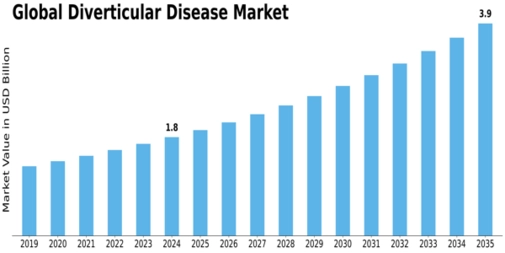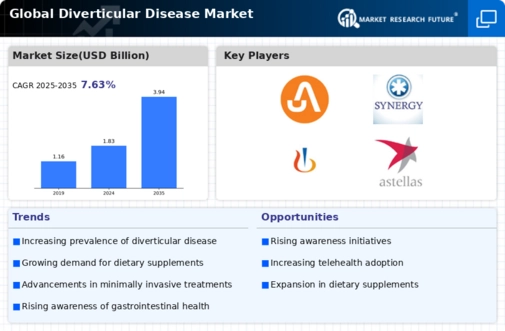Diverticular Disease Size
Diverticular Disease Market Growth Projections and Opportunities
USD 3.11 billion is the amount that the diverticular disease market size will hit by 2032, with a CAGR of 7.79% during the forecast period. The growth and development of the Diverticular Disease Market are affected by various factors that interact over time in sometimes mysterious ways. Diverticular disease, which is a common digestive condition involving the formation of small pouches (diverticula) on the colon's walls, has necessitated effective treatment methods, hence shaping overall market dynamics. For instance, an increase in the global prevalence of diverticular diseases is one of the main factors influencing this market. Indeed, research and development (R&D) efforts play a crucial role in molding the dynamics of the Diverticular Disease Market. With a view to mitigating symptoms and complications associated with diverticular disease, pharmaceutical companies, as well as researchers, are vigorously involved in developing innovative drugs and therapies for this condition. The availability of more treatments due to ongoing clinical trials, drug formulation improvements, and patient-friendly treatment options drive market expansion positively. Technological advancements also have an impact on the market dynamics regarding treatments for diverticular diseases. Overall, management for patients having diverticulitis has been improved through advances in diagnostic imaging techniques, endoscopic procedures, and minimally invasive surgeries, respectively. Regulatory considerations, together with approval processes, significantly affect how technology adoption takes place in markets offering solutions for diverticulitis conditions, among many others. Competition among pharmaceutical companies and healthcare stakeholders plays a critical role here, too. To do this, firms use several tactics, including mergers, acquisitions, and collaborations, thereby reinforcing their positions in various markets while widening their product range. The competitive landscape encourages new ideas, thereby creating room for innovation since organizations strive to remain different from each other by introducing fresh and better modes/methods/mechanisms/treatment approaches when it comes to dealing with/for/diverticulum sufferers. Economic factors also play a role in shaping the market dynamics of diverticular disease treatments. Healthcare spending patterns are affected by economic conditions, which in turn can influence the affordability and accessibility of treatments for patients. During economic downturns, cost-conscious approaches to health care may slow market growth in this area of study. Conversely, a robust economy stimulates more investment in healthcare, thereby driving the demand for diverticulosis treatment. Consumer preferences and awareness contribute significantly to market dynamics. An increased level of knowledge concerning diverticular disease and its implications on daily life leads to timely treatment, thus causing a rise in demand for medical assistance from the market. The way patients want/like things done/the way they like receiving their services highly influence how markets behave. Increased awareness about diverticular disease and its impact on daily life prompts individuals to seek timely treatment, driving market demand. However, consumer preferences play an important role; for instance, when people want non-invasive therapies or personalized medicine with no side effects.








Leave a Comment